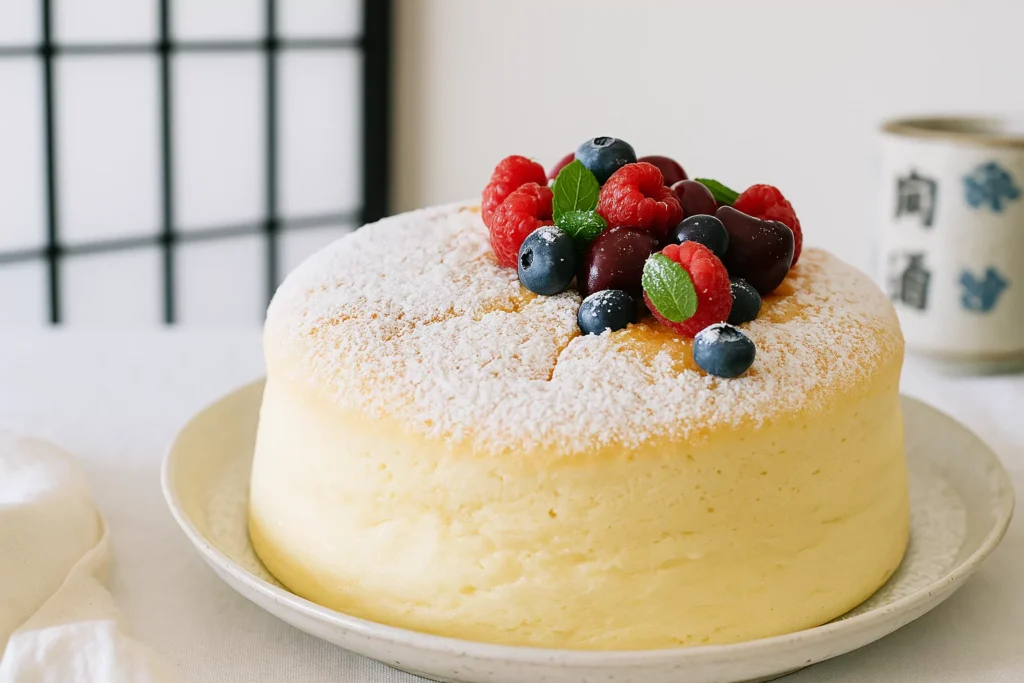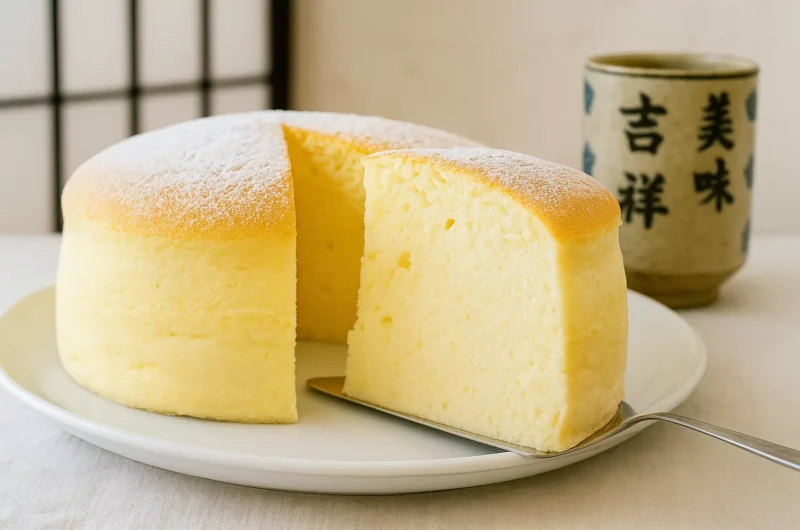Have you ever wondered how a cheesecake could be as fluffy as a cloud, yet melt in your mouth like a dream? It may sound too good to be true, but that’s exactly what makes Japanese Cheesecake so special. Unlike the dense and rich American-style version, this dessert is light, airy, and almost magical. If you’ve ever seen those wobbly cakes on social media, chances are you’ve already encountered the charm of the Japanese Cheesecake.
Jump to Recipe Print RecipeWhat Makes Japanese Cheesecake So Special?
Japanese Cheesecake, also known as cotton cheesecake or soufflé cheesecake, is unique for its texture. It’s bouncy, jiggly, and so soft it practically floats off your fork. The secret? Whipped egg whites folded into the batter and a gentle bake in a water bath. This process creates a sponge-like consistency that is lighter than air but full of flavor.
Time-wise, this dessert does require some patience. Including cooling and chilling, it takes about 6 to 8 hours from start to finish. The actual prep and baking take less than 2 hours, but the wait is worth every second. As for difficulty, it’s beginner to intermediate level. Anyone who follows the steps carefully can succeed.
Table of Contents
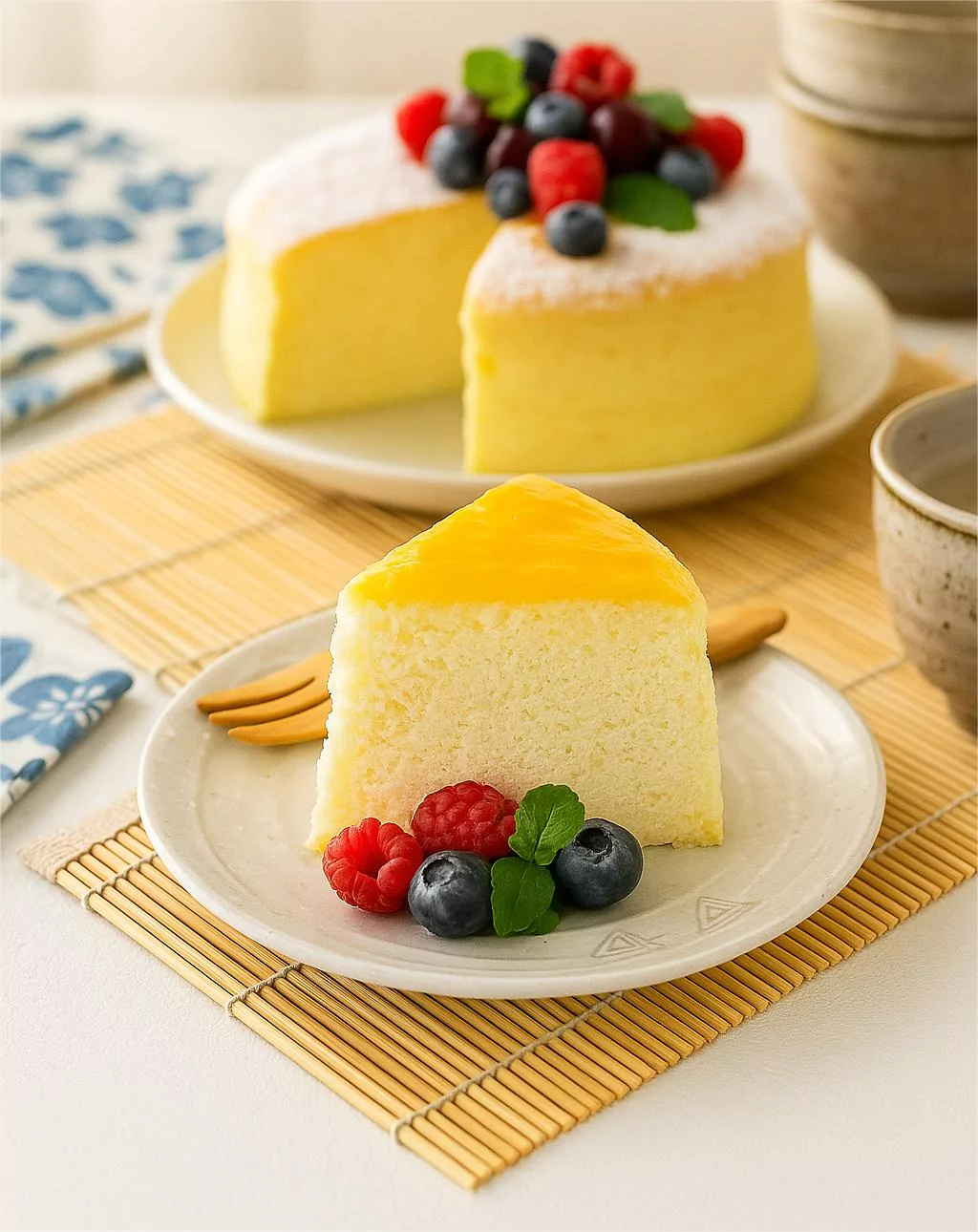
Japanese Cheesecake スフレチーズケーキ @JapanDishes
What Is Japanese Cheesecake?
Japanese Cheesecake was created by pastry chef Yasui Juichi at the Plaza Hotel in Osaka. His version took the richness of Western cheesecakes and lightened it with techniques more common in French pastries. In Japan, it’s called “sufure chīzukēki” (スフレチーズケーキ), referring to its soufflé-like rise and airy texture.
Unlike traditional cheesecakes, this one doesn’t use a crust. Instead, it’s baked directly in a lined pan using a water bath to keep it moist and evenly cooked. This avoids cracks and creates its signature jiggly appearance.
For a perfect pairing, enjoy your Japanese Cheesecake with a refreshing Iced Hojicha Latte a lightly roasted Japanese tea drink that complements the delicate flavor of the cake.

Japanese Cheesecake @JapanDishes
Essential Ingredients
Here’s what you’ll need to create the magic:
- Cream Cheese (10.6 oz): The heart of any cheesecake. Use full-fat for the best flavor and texture.
- Unsalted Butter (4 Tbsp + 1 Tbsp): Adds richness and helps with a smooth batter. One tablespoon is used to grease the pan.
- Heavy Cream (200 ml): You can substitute whole milk, but heavy cream gives a richer mouthfeel.
- Sugar (4½ Tbsp + ½ cup): Divided for the cream cheese mixture and for the meringue.
- Cake Flour (⅔ cup): Lighter than all-purpose flour and perfect for a soft, delicate cake.
- Lemon (zest and 2 Tbsp juice): Adds brightness to balance the richness.
- Eggs (6 large, separated): The whites are whipped into meringue to give the cake its fluffy texture.
- Apricot Jam (2 Tbsp): Mixed with water for a shiny glaze.
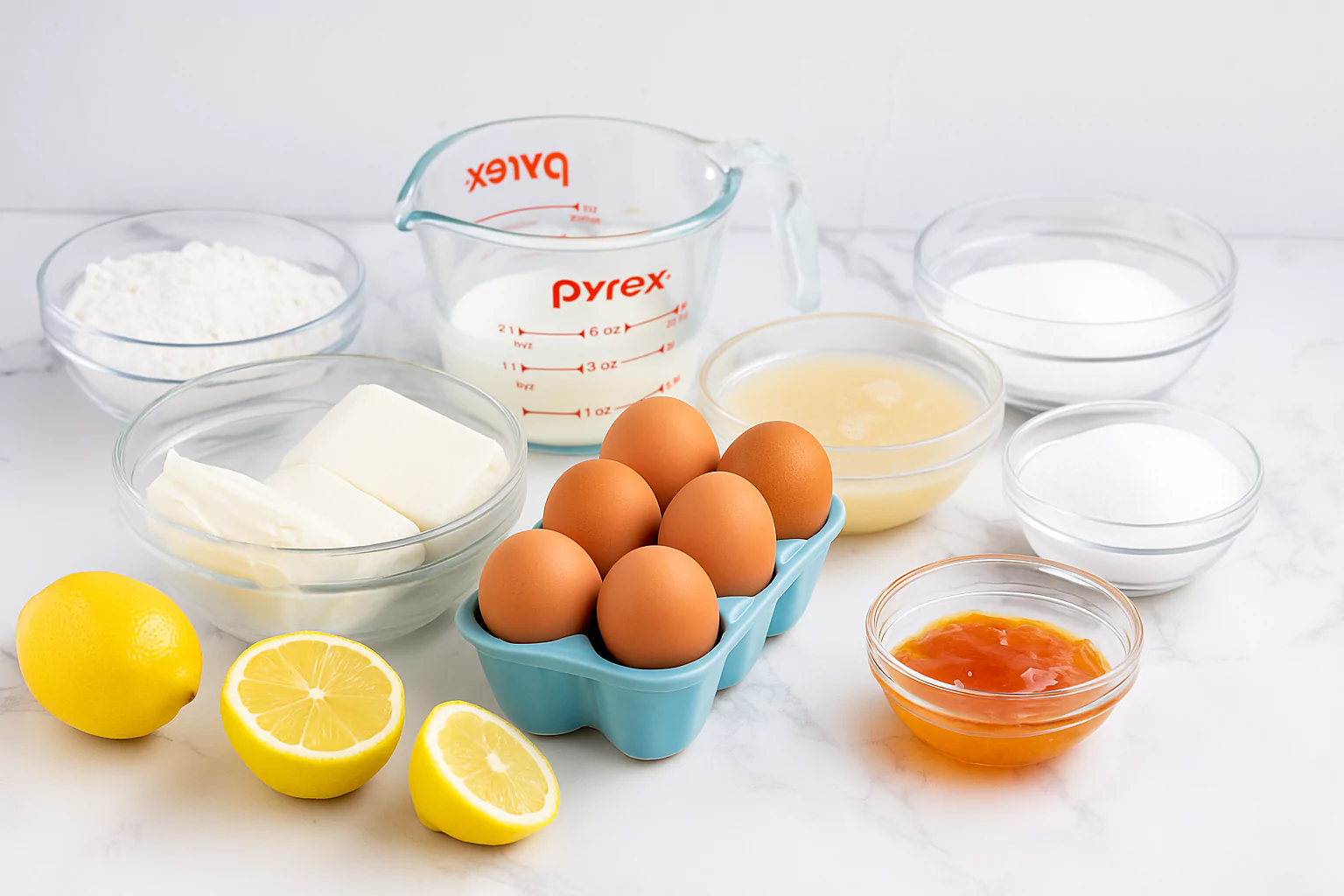
Japanese Cheesecake Ingredients @JapanDishes
Substitutions & Variations:
- Use orange zest or juice for a citrus twist.
- If you don’t have cake flour, make your own with a mix of all-purpose flour and cornstarch.
- Replace apricot jam with honey or a fruit glaze of your choice.
Step-by-Step Instructions
1. Prepare Your Pan
Grease a 9-inch round pan with unsalted butter. Line the bottom and sides with parchment paper. Make two long strips to form an “X” at the bottom to help lift the cake later.
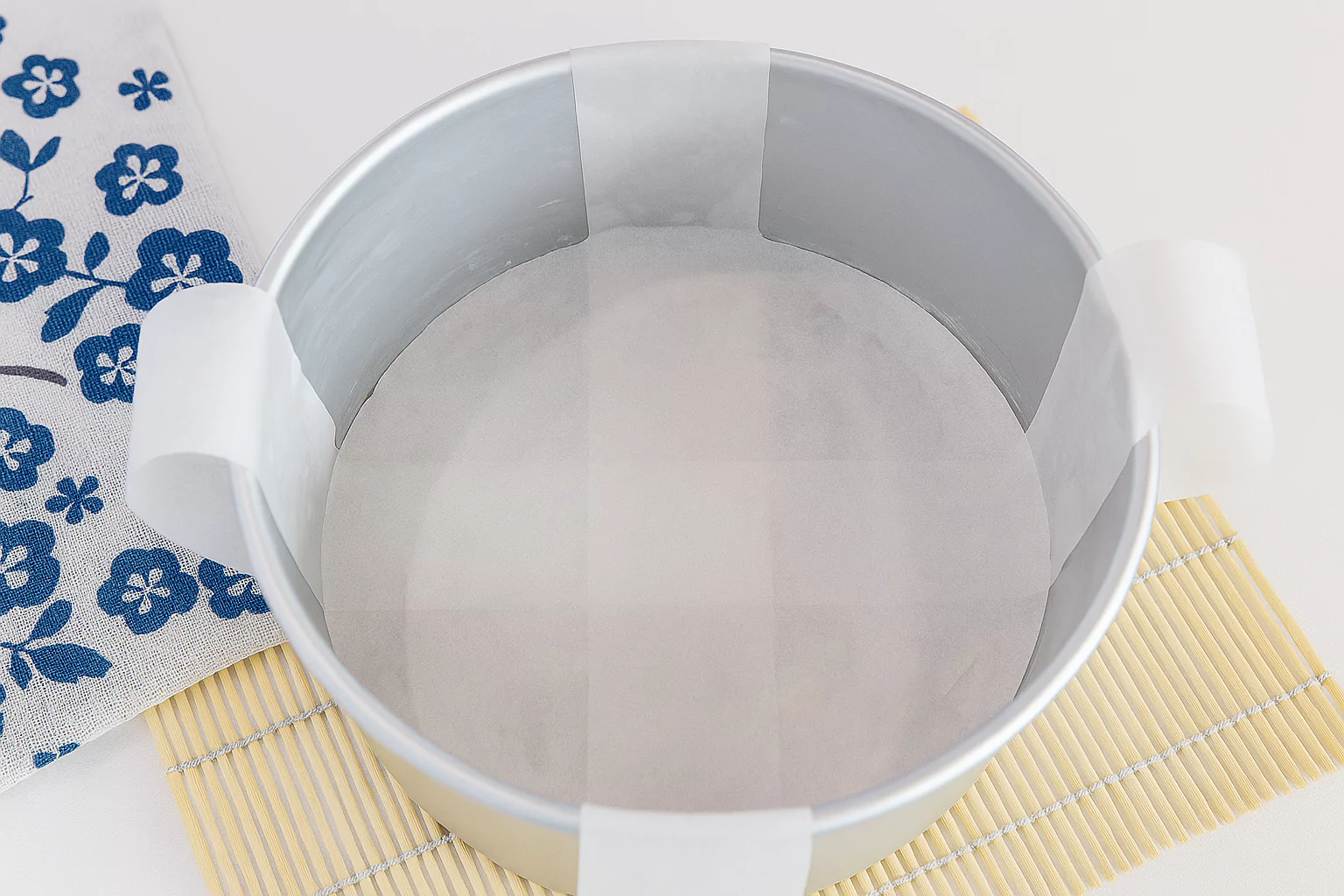
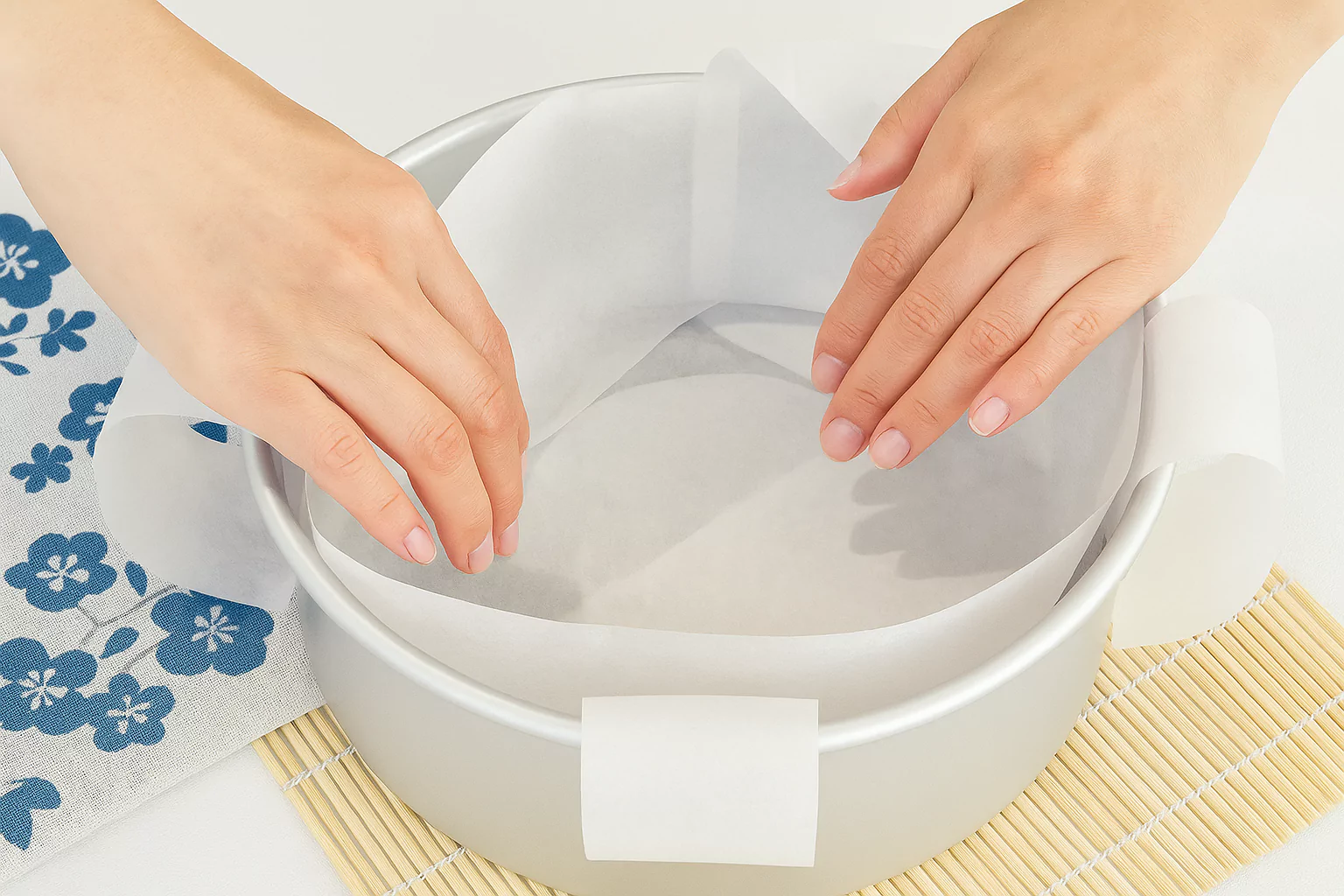
2. Preheat Oven and Setup Water Bath
Preheat your oven to 350°F. You’ll later reduce the temperature to 320°F when baking. Place a large baking sheet in the oven and fill it halfway with hot water.
3. Make the Batter
In a large bowl over simmering water, combine cream cheese, 4 Tbsp butter, sugar (4½ Tbsp), and heavy cream. Stir until smooth. Remove from heat.
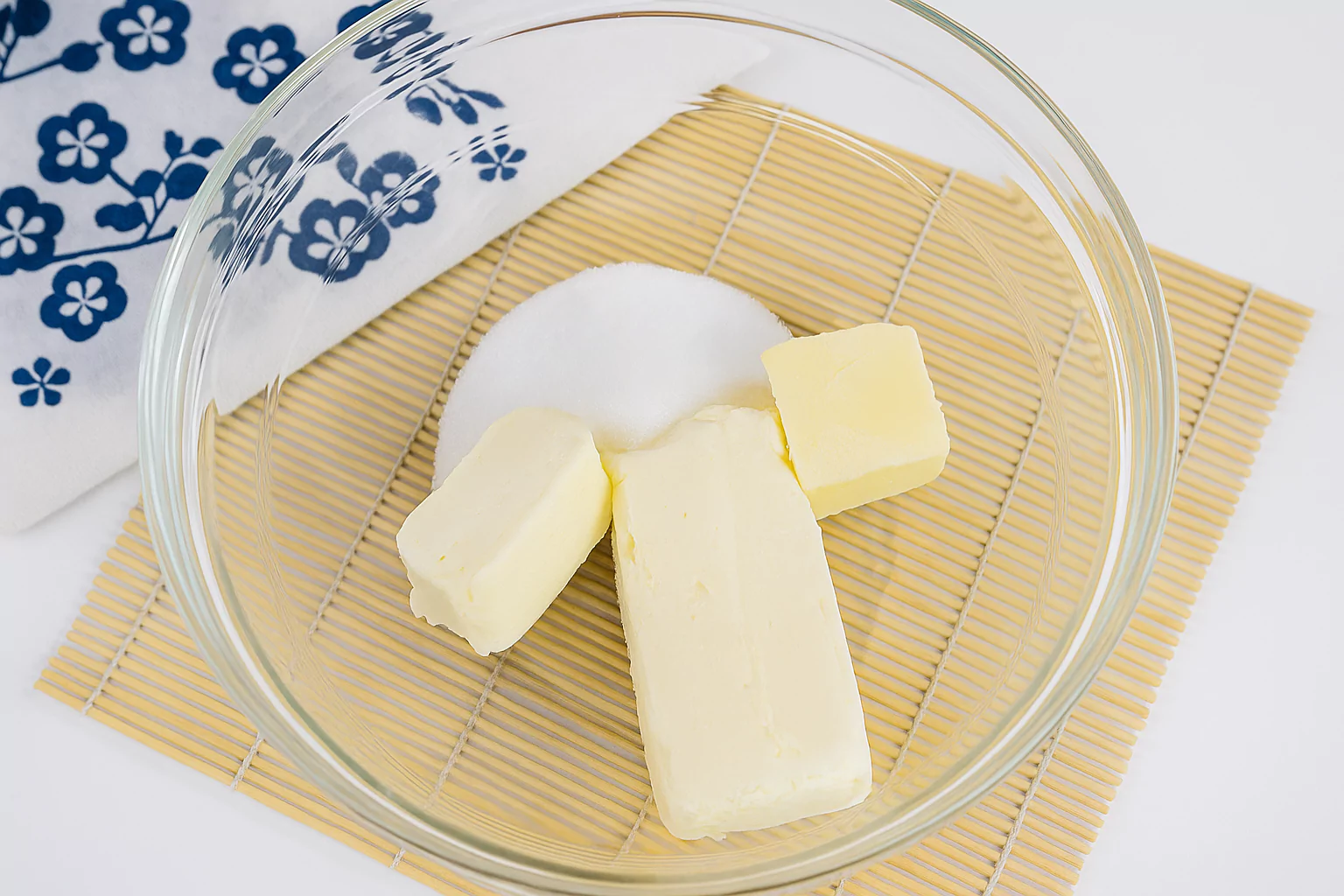
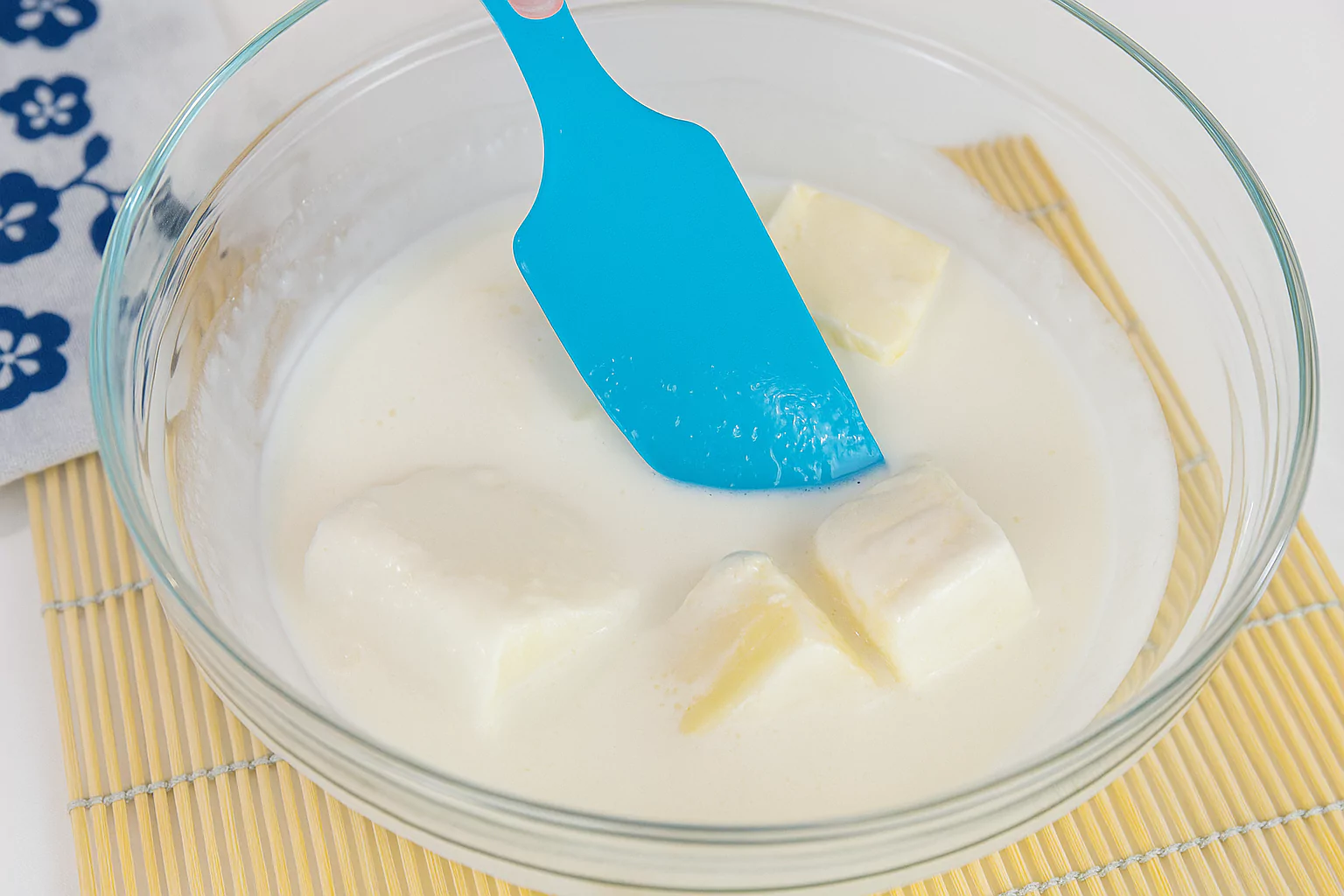
Add egg yolks, one at a time, whisking well after each addition. Sift in cake flour and mix until smooth. Strain the batter to remove lumps. Add lemon zest and juice. Set aside.
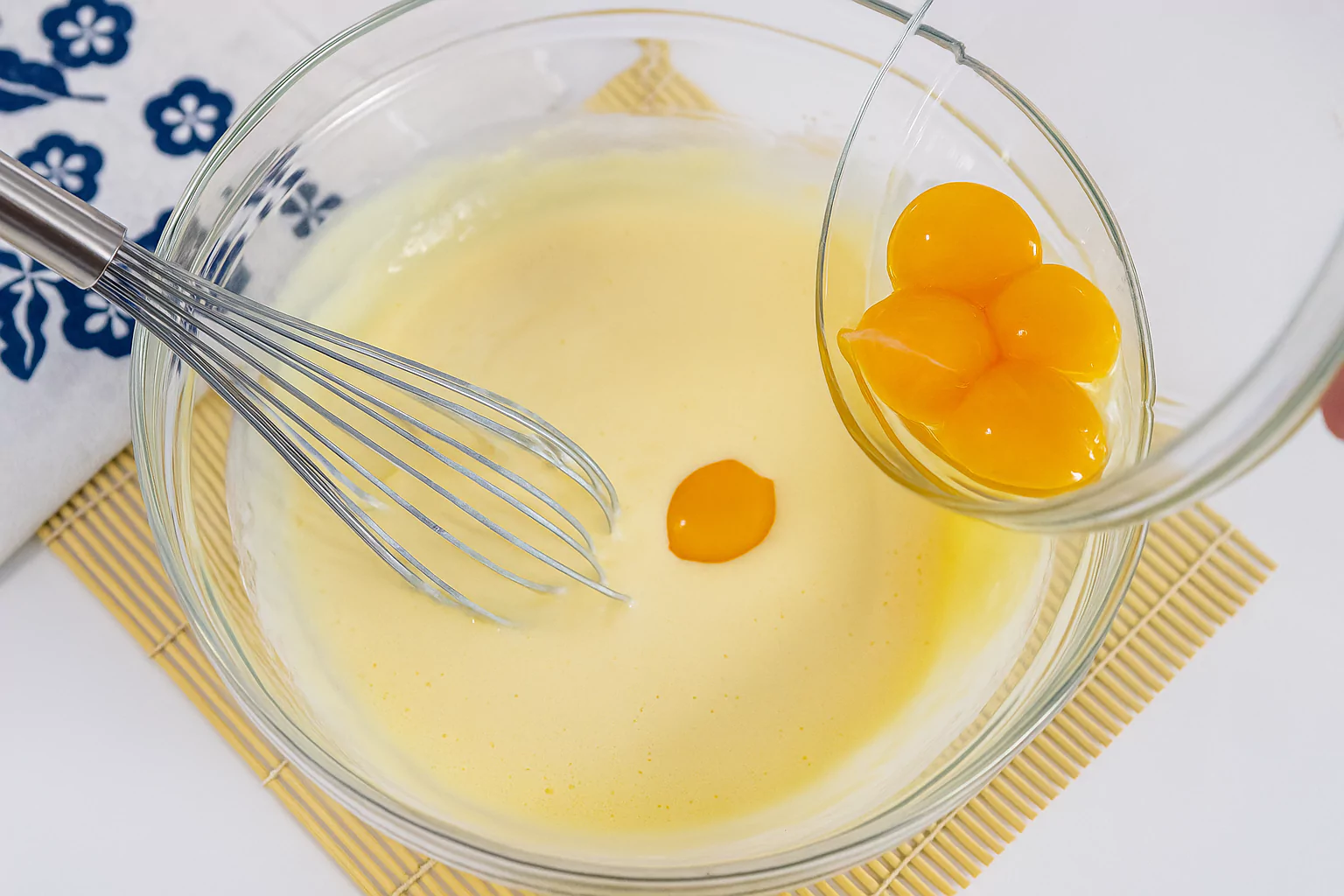
4. Whip the Egg Whites
In a clean, dry bowl, beat egg whites until foamy. Slowly add ½ cup sugar in thirds, continuing to beat until firm peaks form.
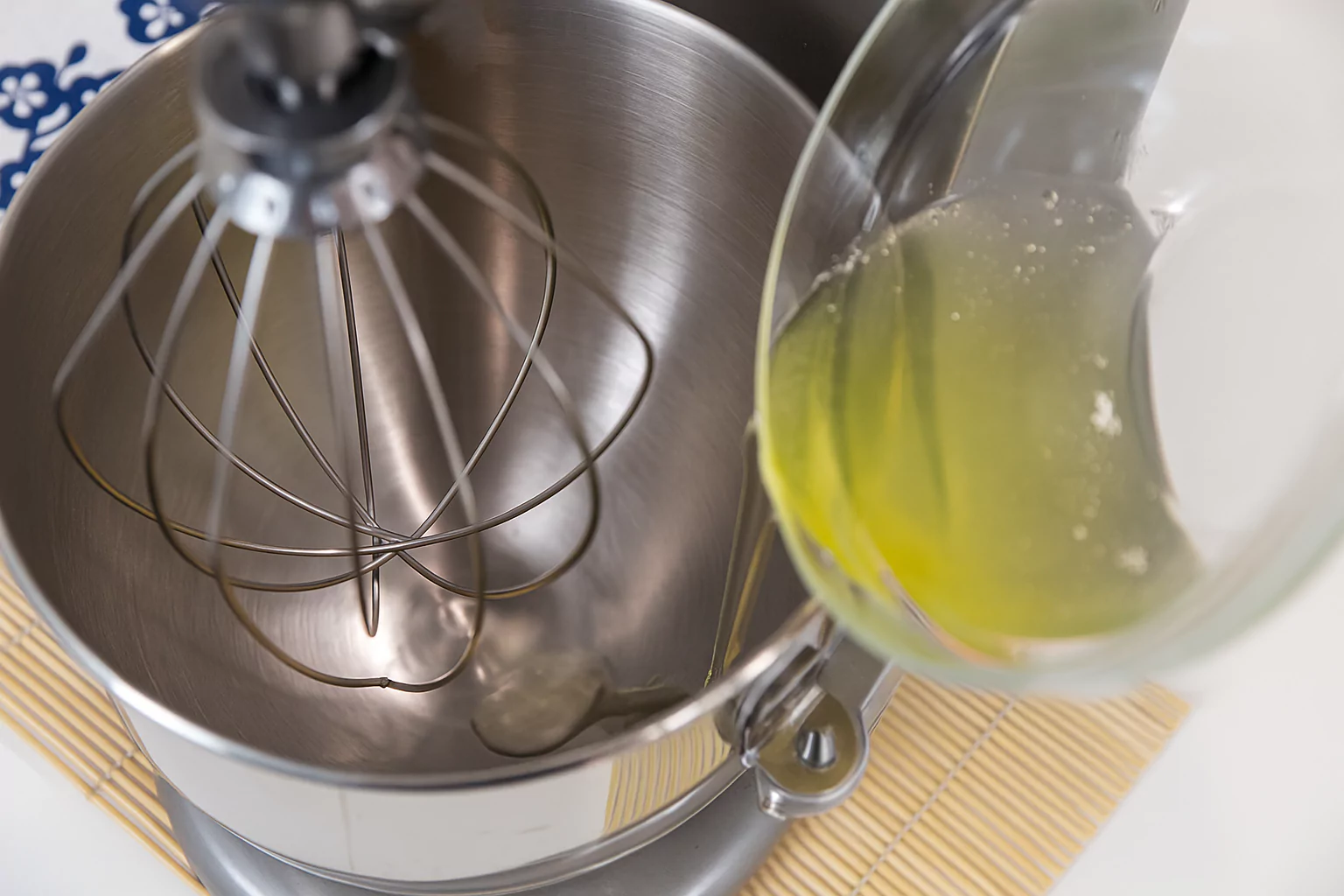
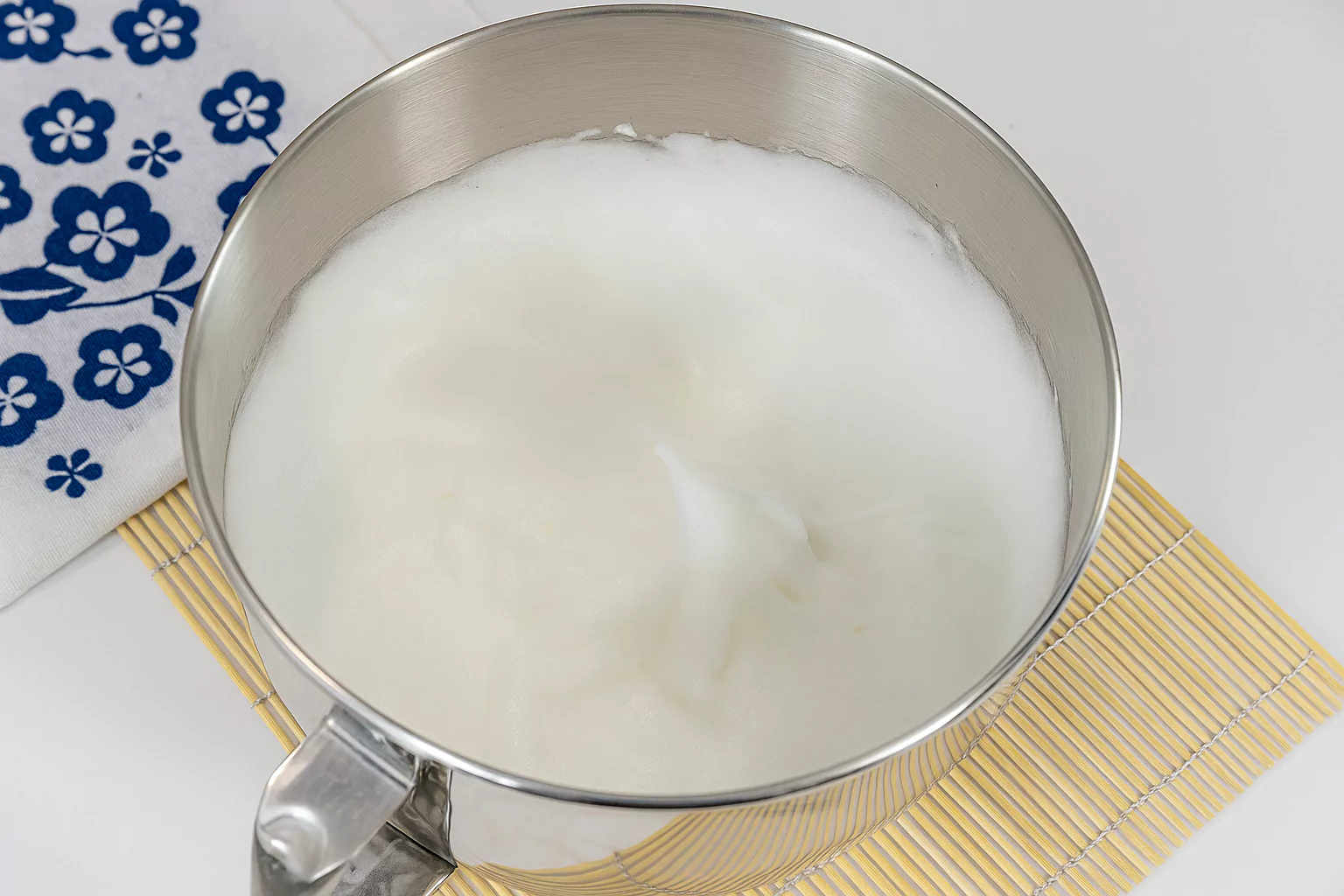
5. Combine
Gently whisk one-third of the meringue into the batter. Then fold in another third, and finally fold the batter into the remaining meringue. Be gentle to keep the volume.
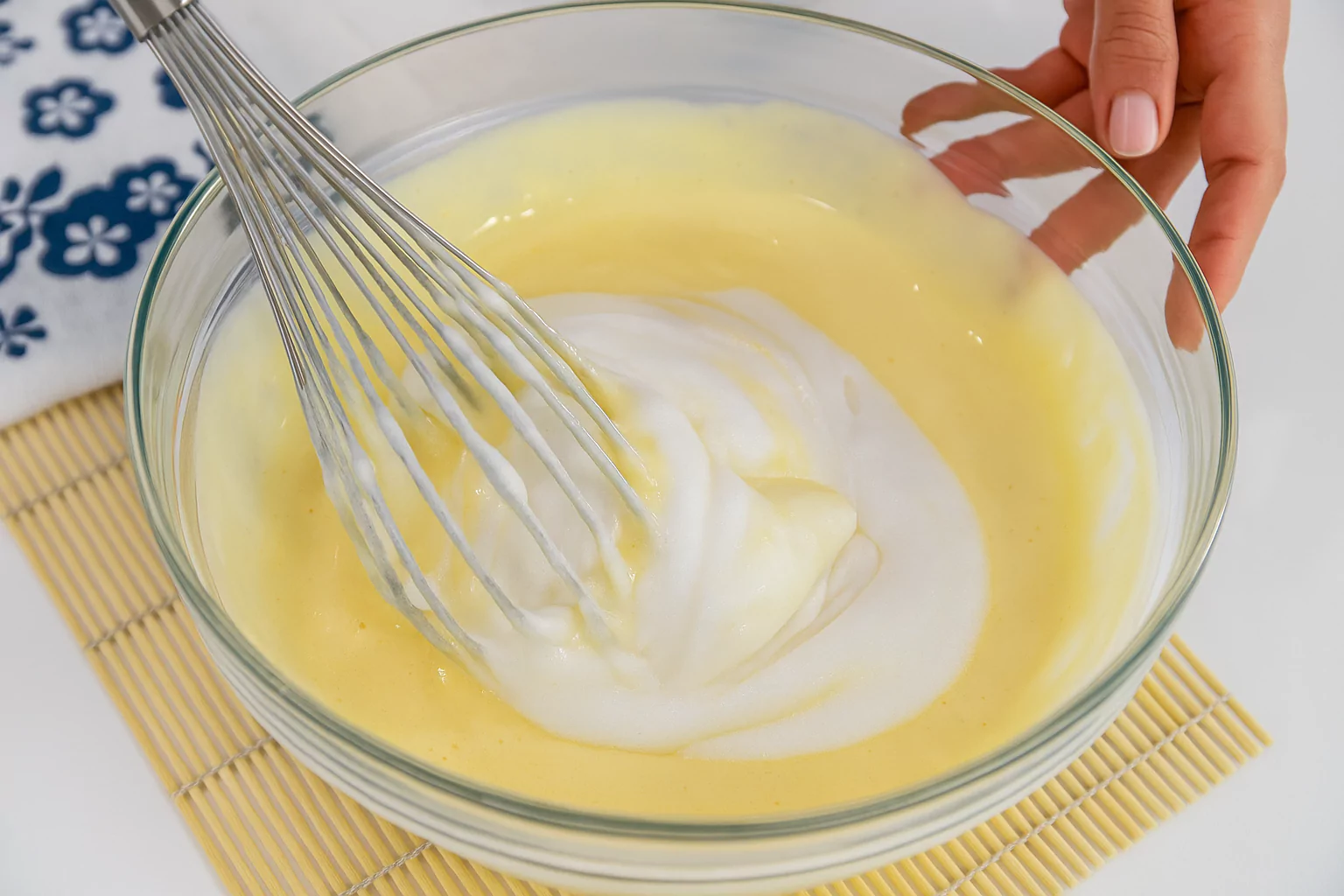
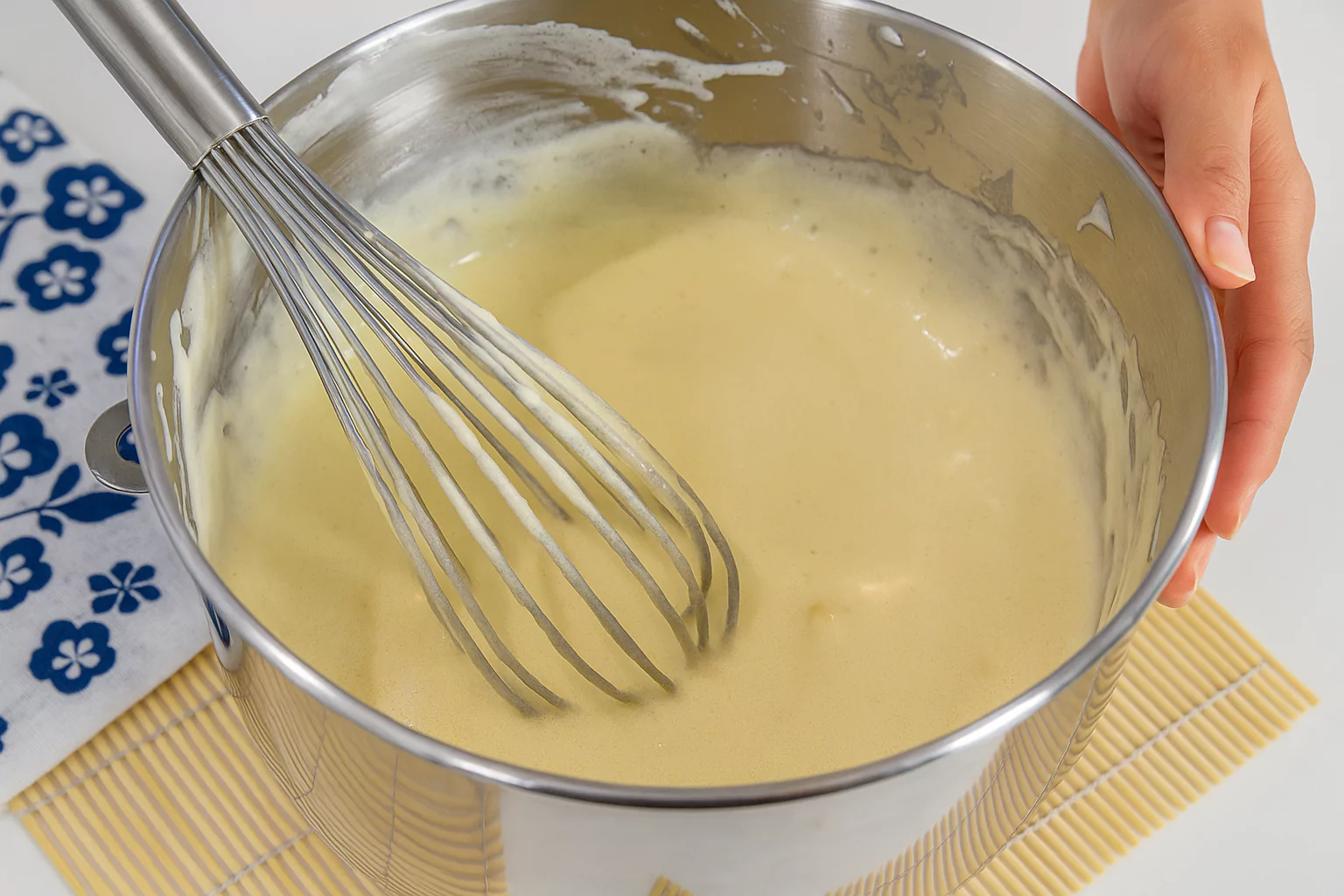
6. Pour and Bake
Pour batter into the prepared pan. Tap the pan on the counter to remove air bubbles. Place it in the water bath and bake at 320°F for 70–75 minutes. Lower the temperature to 300°F and bake for another 10 minutes.
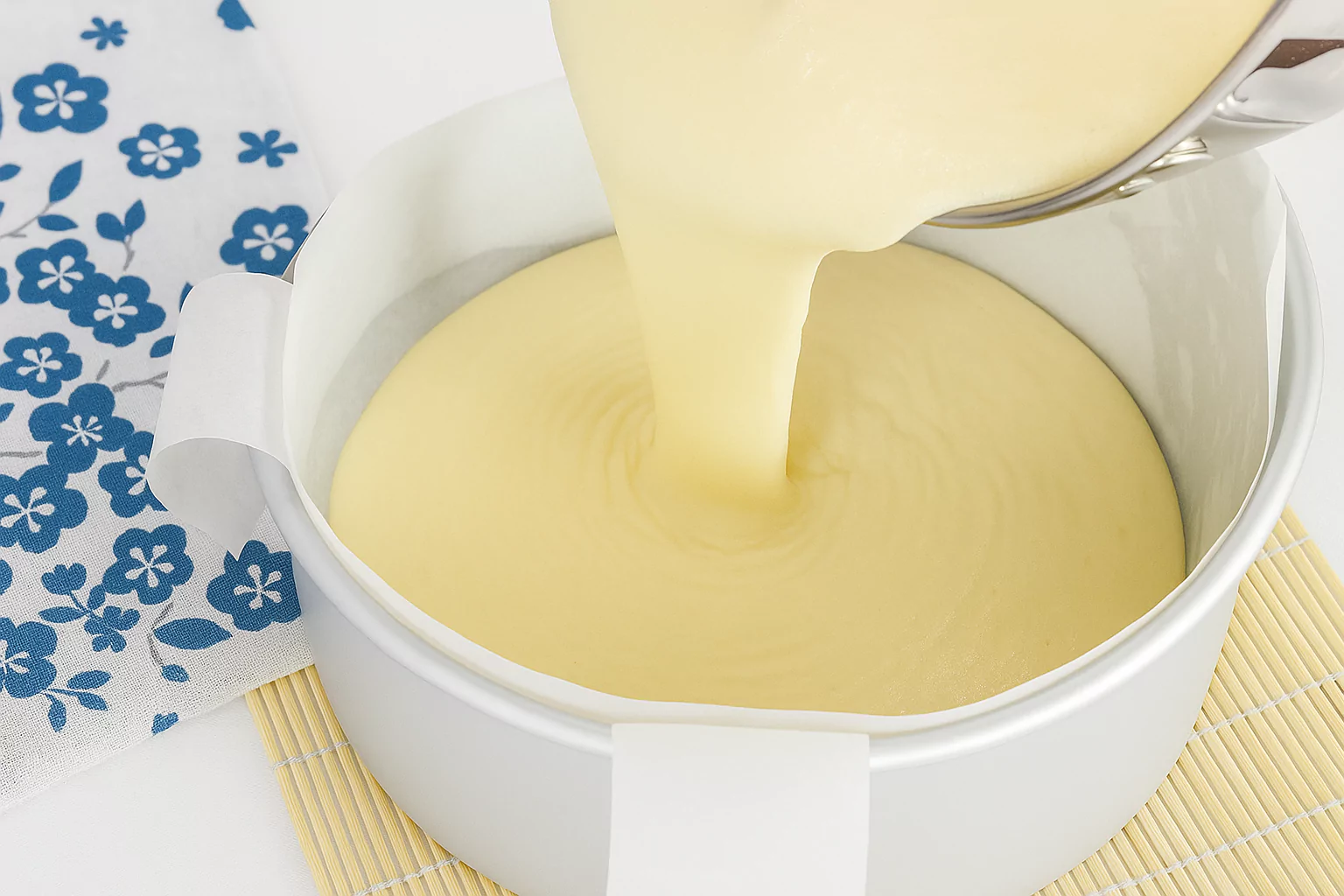
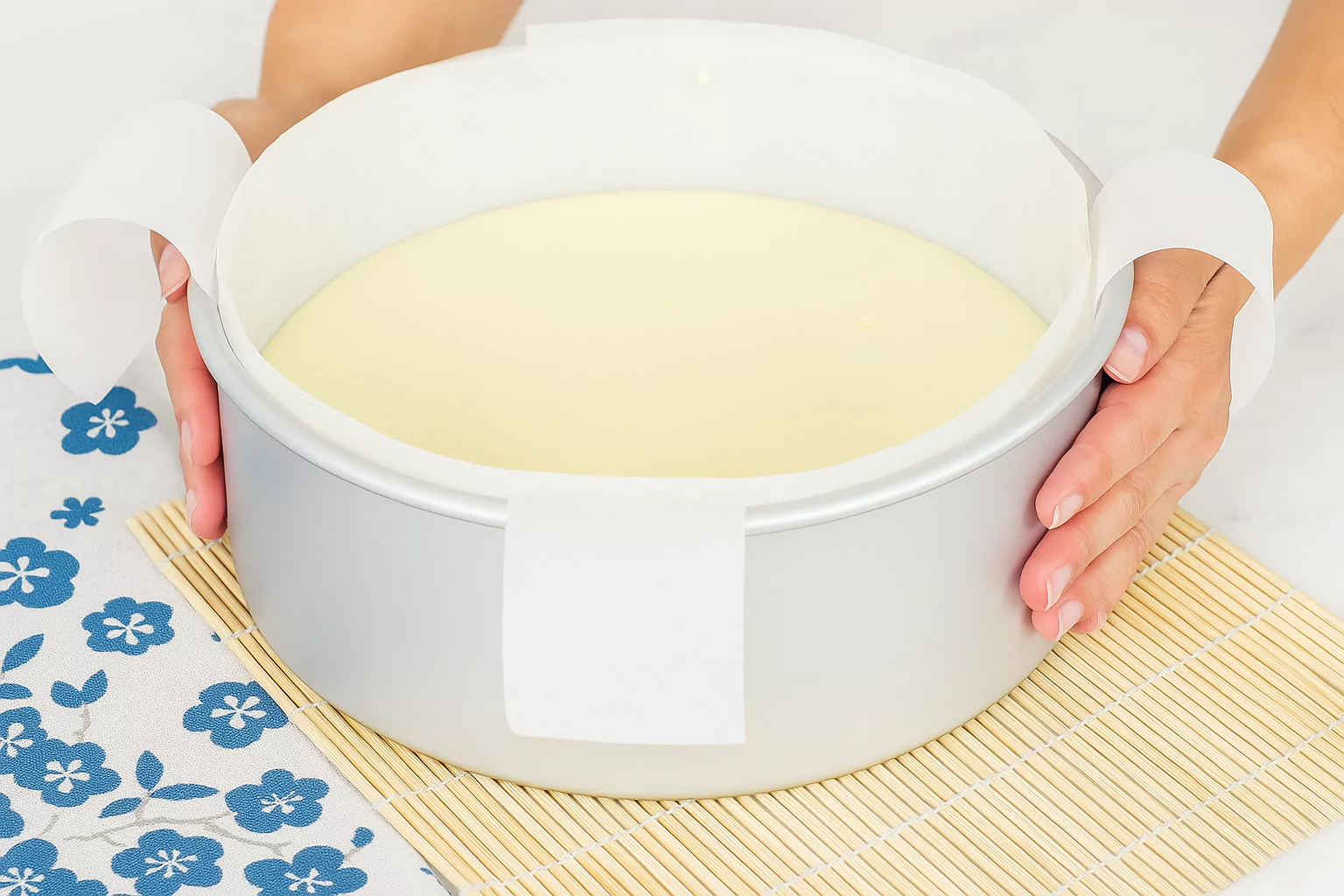
Check for doneness with a skewer. If it comes out clean, the cake is ready.
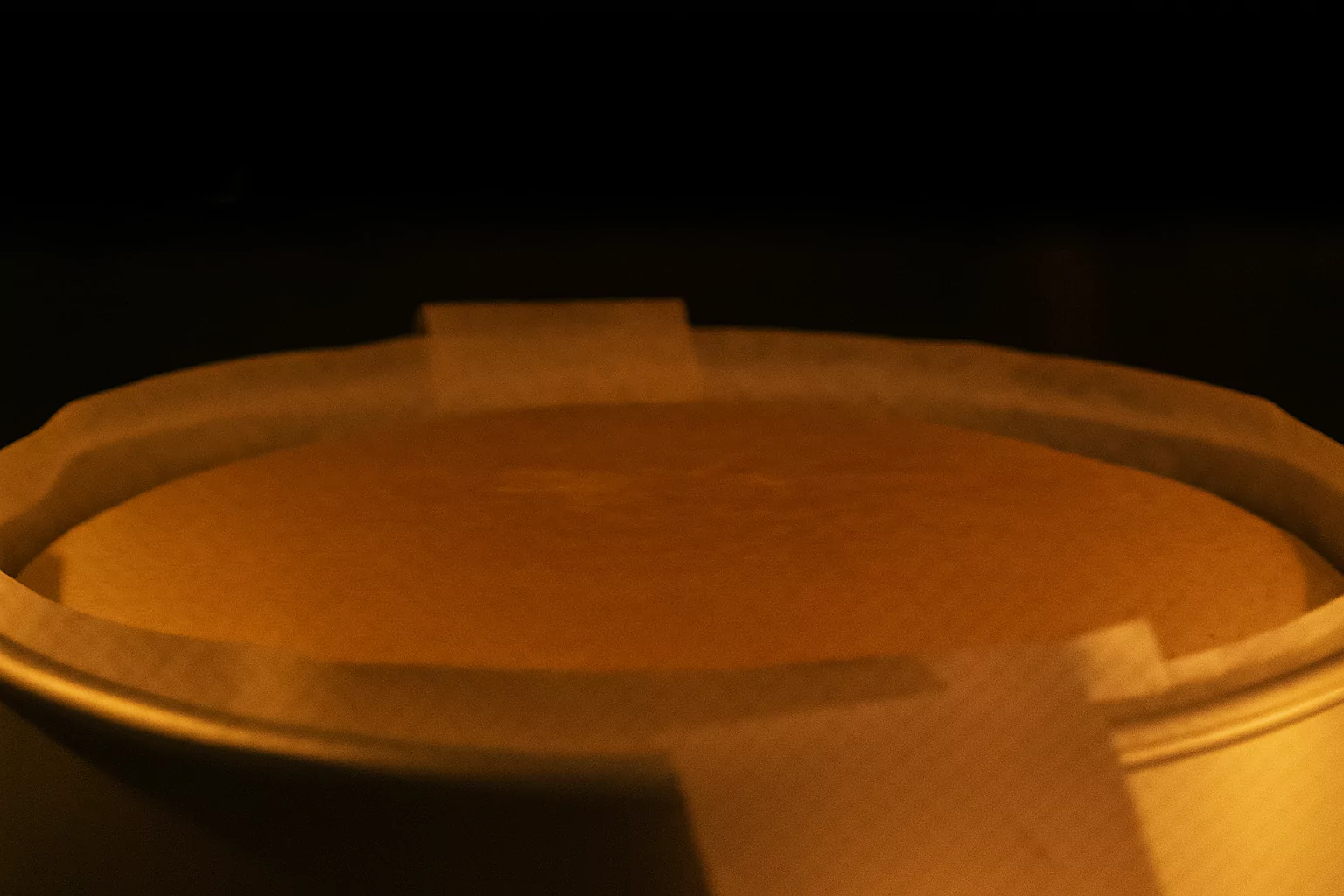
7. Cool Gradually
Turn off the oven and leave the cake inside with the door ajar for 15–20 minutes. This prevents sudden shrinkage.
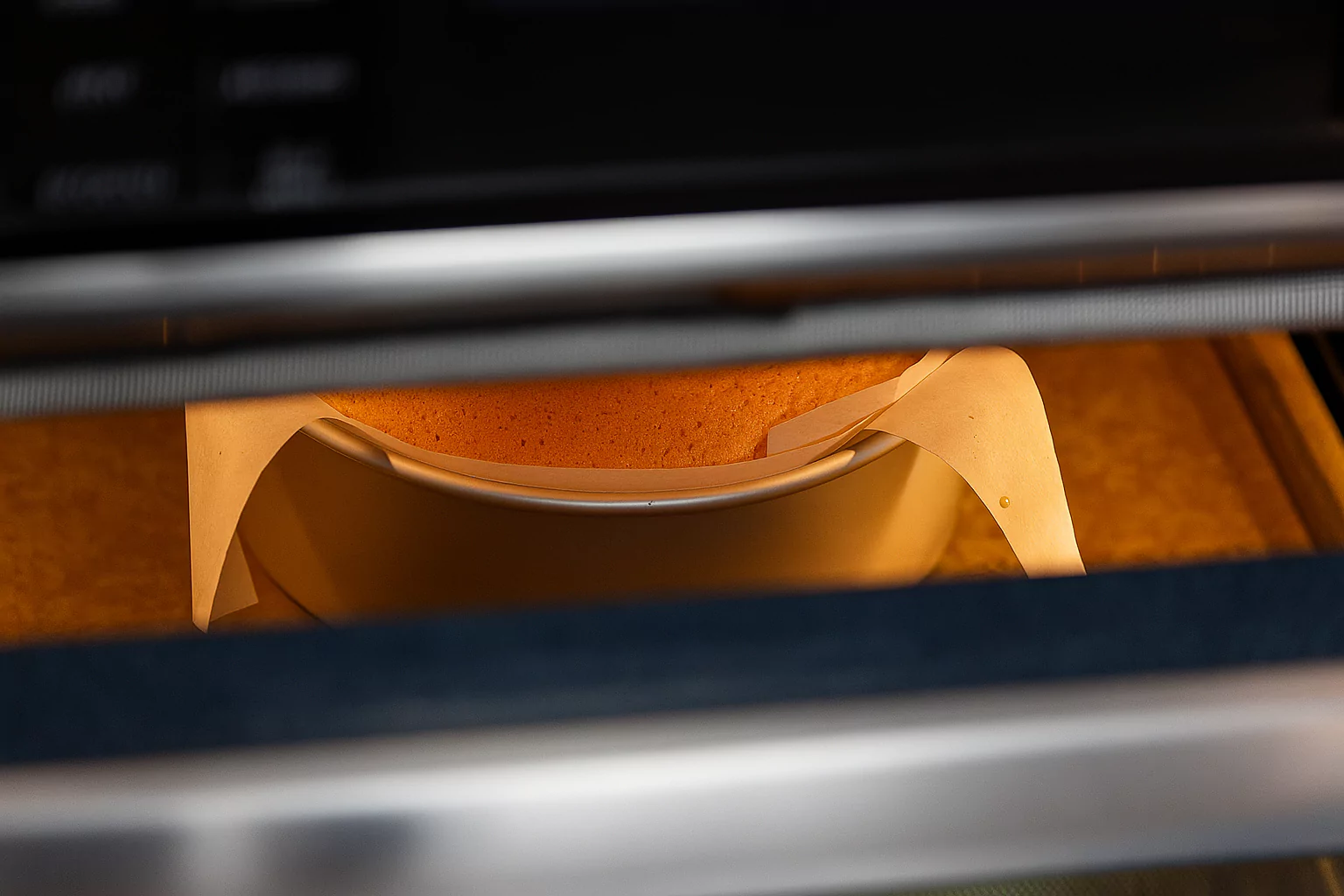
8. Remove and Glaze
Carefully lift the cake out using the parchment straps. Mix apricot jam with hot water and brush over the top for a shiny finish.
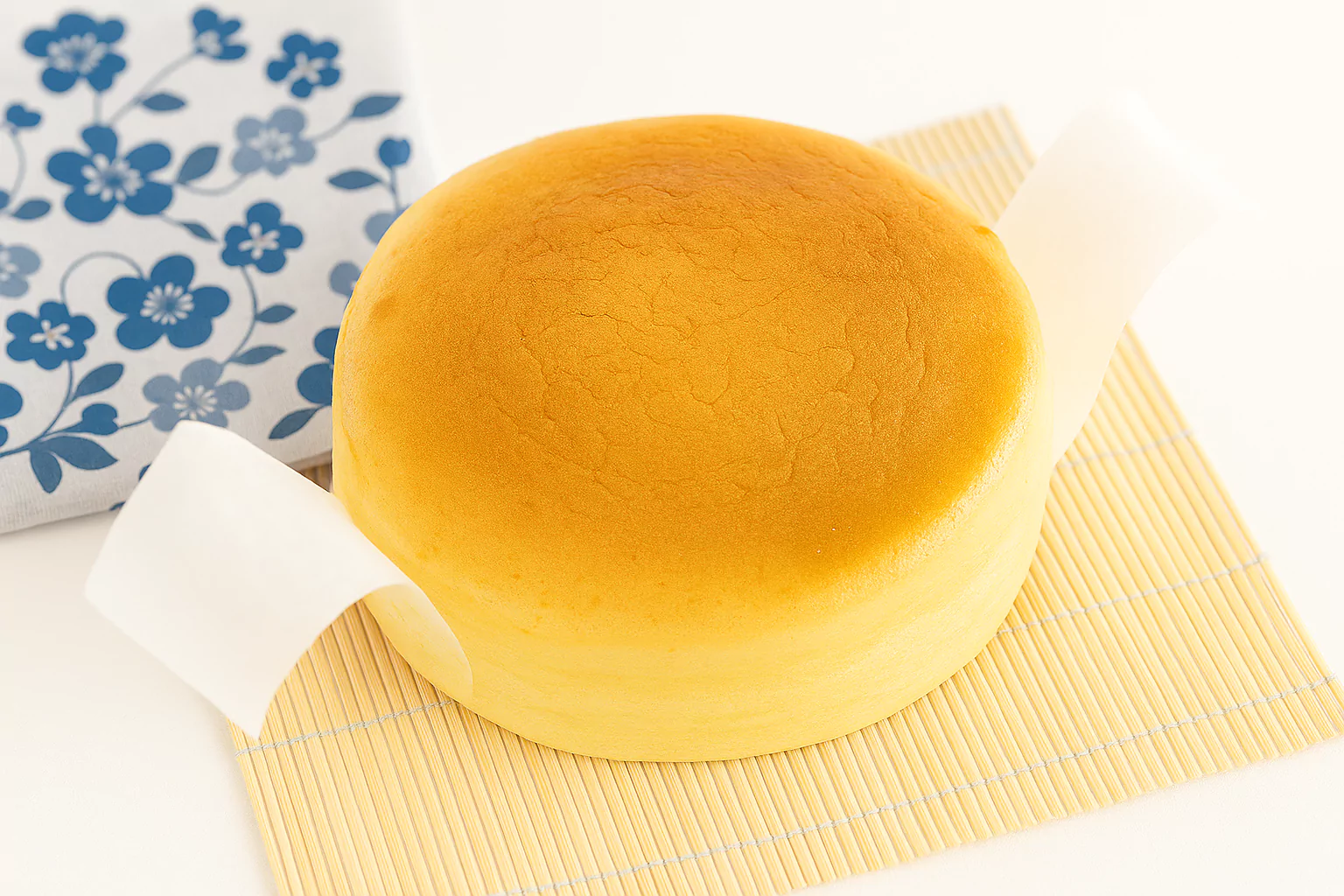
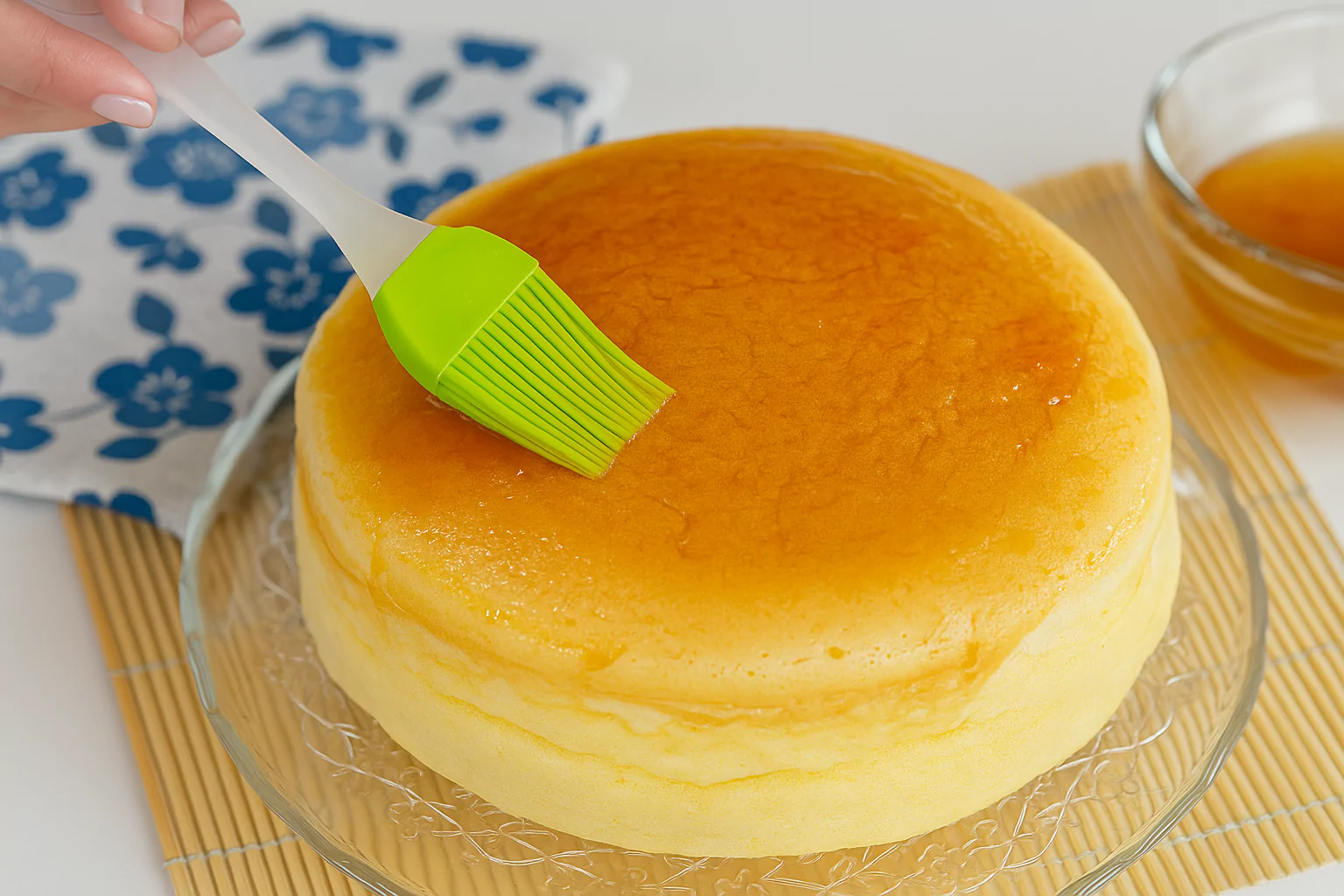
Hana’s Recipe Tips
- Always use room-temperature eggs to help the whites whip better.
- Straining the batter is key for that silky texture.
- Avoid overmixing the meringue into the batter, or the cake might deflate.
- Use a clean, oil-free bowl for beating egg whites. Even a drop of fat can prevent stiff peaks.
Assembly and Presentation
Pour your final batter gently into the pan to maintain the air bubbles. Once baked and cooled, remove it carefully and place it on a serving plate.
Dust the top lightly with powdered sugar or garnish with fresh fruit. This dessert looks elegant on a white or pastel-colored plate.
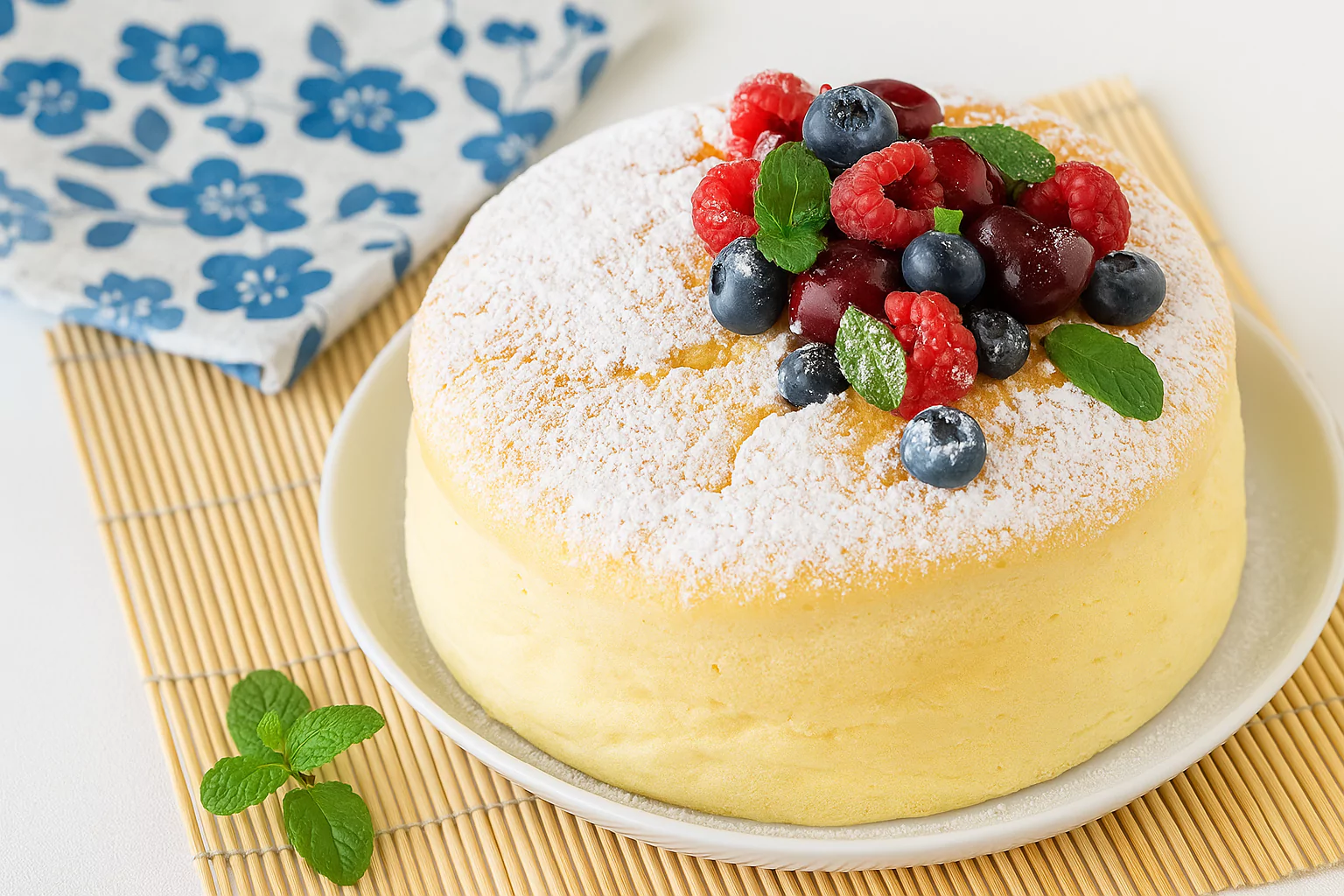
Storage and Make-Ahead Tips
- Refrigeration: Store in an airtight container in the fridge for 3 to 4 days.
- Freezing: Wrap slices individually in plastic wrap, then foil, and freeze for up to 1 month. Thaw in the fridge overnight.
- Serving: Let chilled slices sit at room temperature for 10–15 minutes for the best texture.
Recipe Variations
- Matcha Cheesecake: Add 1 Tbsp matcha powder to the batter.
- Chocolate Swirl: Add melted dark chocolate and swirl it before baking.
- Berry Bliss: Fold in some blueberries or raspberries for a fruity twist.
Conclusion
Now that you know the secrets to this fluffy, jiggly delight, it’s time to try making your own Japanese Cheesecake. While it takes a bit more time than a no-bake dessert, the texture and flavor are like nothing else. Whether you’re impressing guests or just treating yourself, this recipe is a must-try.
Japanese Cheesecake スフレチーズケーキ
Course: Main CoursesCuisine: JapaneseDifficulty: Medium8
servings30
minutes1
hour25
minutes230
kcalThis Japanese Cheesecake, also known as スフレチーズケーキ, is light, jiggly, and melt-in-your-mouth delicious. A fluffy and creamy dessert that’s perfect with tea or coffee.
Ingredients
1 Tbsp unsalted butter (for greasing the pan)
6 large eggs (separated, ~300g without shell)
10.6 oz full-fat cream cheese
4 Tbsp unsalted butter (for batter)
200 ml heavy cream (or whole milk)
4½ Tbsp sugar (for cream cheese mixture)
⅔ cup cake flour
½ lemon (zest and juice)
2 Tbsp lemon juice
½ cup sugar (for egg whites)
2 Tbsp apricot jam
2 tsp hot water (for glaze)
Directions
- Prepare the Pan
Butter a 9-inch cake pan and line with parchment paper. Make two paper straps and place them in an “X” shape on the bottom. - Preheat and Water Bath Setup
Preheat oven to 350°F (180°C). Place a deep baking tray in the oven with hot water for a water bath. - Make the Cream Base
In a heatproof bowl, combine cream cheese, 4 Tbsp butter, heavy cream, and 4½ Tbsp sugar. Set over a simmering pot of water and whisk until smooth. - Add Yolks and Flour
Remove from heat. Whisk in the egg yolks one at a time. Sift in the cake flour and whisk well. Add lemon zest and 2 Tbsp lemon juice. - Strain Batter
Strain the batter through a fine mesh sieve into a clean bowl for extra smoothness. - Beat Egg Whites
Beat egg whites on medium speed until foamy. Gradually add ½ cup sugar and beat to firm peaks. - Fold Together
Fold one-third of the egg whites into the batter, then gently fold in the rest in two more additions. - Bake in Water Bath
Pour batter into the prepared pan. Tap to remove air bubbles. Bake at 320°F (160°C) for 70–75 minutes, then lower to 300°F (150°C) for 10 minutes until golden. - Cool Gradually
Turn off oven and leave the cake inside with the door ajar for 15–20 minutes to prevent collapse. - Remove and Glaze
Lift cake using parchment straps. Brush the top with apricot glaze made by mixing jam and hot water. - Chill and Serve
Cool at room temperature, then refrigerate for at least 4–6 hours. Slice with a warm knife for neat edges.
Notes
- For best texture, use a digital kitchen scale for precise measurements.
You can store the cake in the fridge for up to 4 days or freeze for 1 month.
Let it sit at room temp for 10 minutes before serving for a fluffier bite.
Frequently Asked Questions
Q: Why is my cheesecake not rising? A: Check that your egg whites reached firm peaks. Also, be gentle when folding them into the batter.
Q: Can I make this without a water bath? A: The water bath helps prevent cracks and keeps the cake moist. It’s strongly recommended.
Q: Is Japanese Cheesecake healthy? A: It’s lighter than regular cheesecake, lower in fat and sugar. Still a treat, but a lighter one.
Q: Can I make it the night before? A: Yes! In fact, it’s best when chilled overnight.
Q: What makes this different from New York-style cheesecake? A: Japanese Cheesecake is airy and fluffy, while New York-style is dense and creamy.
Give this recipe a try and discover why so many people around the world are falling in love with Japanese Cheesecake. The result is a delicate, flavorful treat that feels just as special to eat as it does to make.
Curious about Japan beyond its cuisine? Discover 7 fun facts about Obama Onsen, a charming hot spring town with surprising history and unique traditions.
